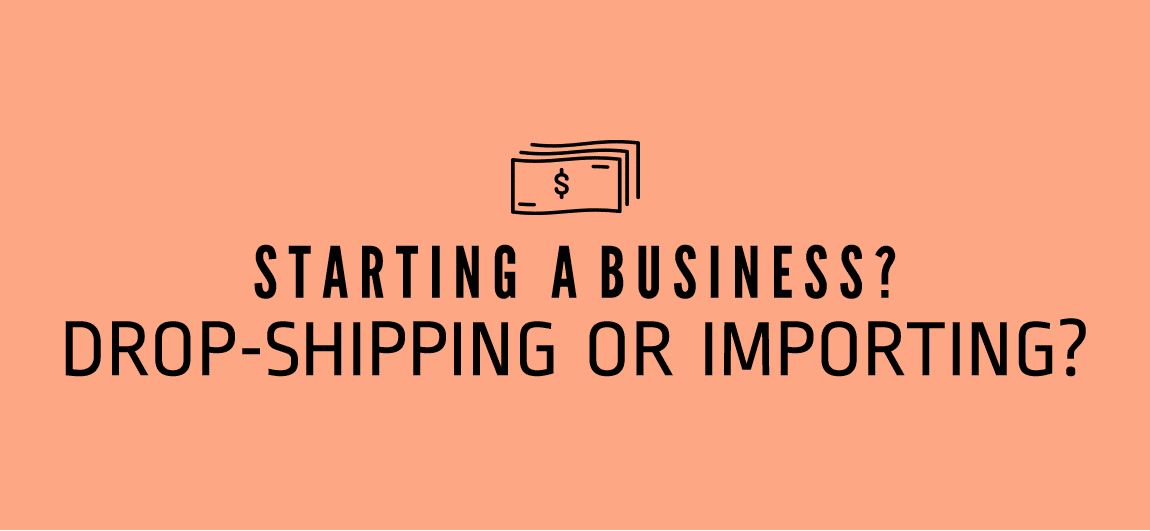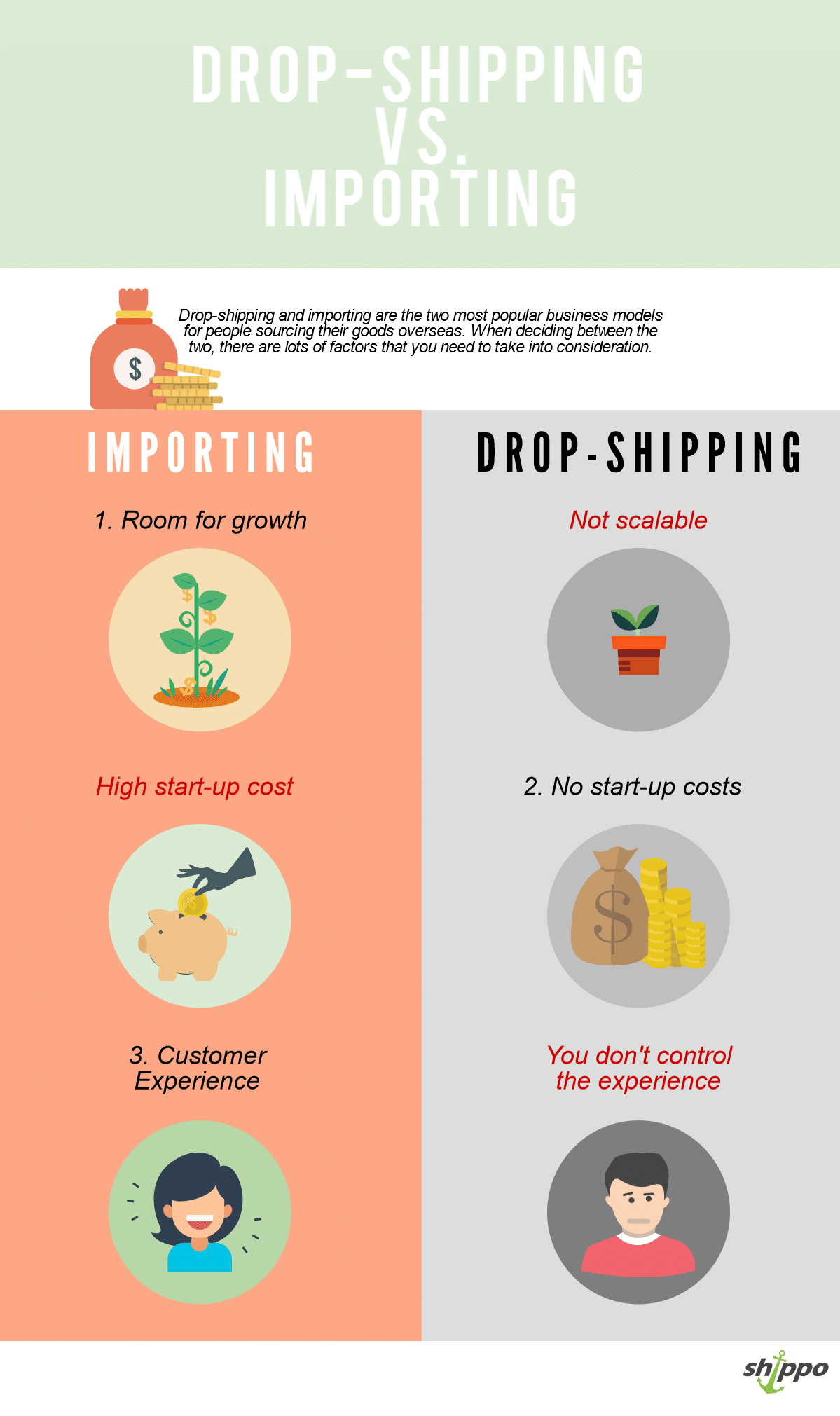You may be thinking about starting up a business – possibly a courageous New Year’s resolution! However, there are many different business models to choose from and finding one that suits your needs and your vision is important. Today, we’re taking a look at two of the most popular business models entrepreneurs may use when sourcing their goods out of the country – drop shipping and importing. So, drop shipping vs importing? Read on to discover more about both models.
-
Drop Shipping Explained
Drop-shipping is a typical business model in the sense that you create an online storefront selling items that other people manufacture. The main attraction, however, is that unlike most businesses you don’t need any stock. You work with a supplier that offers drop-shipping and every time someone purchases something from your site you pay your supplier and they ship out the goods.
You can add on whatever profit you want and you never have to handle the logistics. It’s what sounds like the perfect business model – there are no start-up costs; no potential to lose money and you never have to pay out before you get paid.
How does drop-shipping work?
- You find a supplier that offers drop-shipping capabilities.
- You set up a site selling products.
- From their stock, you choose the items you want to sell and you list these on your site. (With a little profit added on, of course!)
- When someone buys from your site, you pay your supplier and they ship to your customer.
The process itself is simple and definitely has its benefits, but there are a lot of things to take into account. The hands-off approach you take throughout the process results in a lack of control over things like quality, customer experience and growth.
-
Importing Explained
Importing is another great business model. (Plus – it’s one that we can help with!)
Most people have heard of importing businesses; in fact, most businesses are in some form importers. Essentially, you buy goods in bulk at wholesale (extremely cheap) prices and sell them in your home country at market rates. This business model can earn big money and is popular on sites such as Amazon and eBay.
How does importing work?
- You have an idea for a product
- You find a good supplier
- You purchase a large amount of goods from that supplier
- You then get those goods delivered to you and you sell them on
Importing allows you much more control of your business. You have the ability to quality check your products before customers receive them and you aren’t at the mercy of another company. The profit margins are much larger in importing too.
Save
Save
Save
Save
Save
Save
Save
-
Comparing Drop-Shipping and Importing
Aside from obvious differences in the process, the differences between drop-shipping and importing are quite vast. Before committing to one, take a look at what the properties of each are and decide which is best for you.
The first and often most extreme difference is in the customer service and experience:
- Quality of goods received. Drop-shipping means that you have no control of the quality of goods and your customers could receive faulty products. You have no opportunity to check the products and ensure they’re of a suitable standard like you would when you import – you can ensure that your customers don’t receive them.
- Control of whether goods are even shipped. Sometimes suppliers might just take your money and run – but you won’t know until your goods don’t arrive at your customer’s door.
- How quickly goods are shipped. When drop-shipping from China, there’s often a wait of between 2-6 weeks for goods to reach your customer. Not only is this off-putting for potential buyers; it’ll leave you with a lot of worried customers hounding you and asking for their money back. When you import, you have complete control of your goods and how quickly they’re shipped out.
- Subject to your supplier’s whims. Although your supplier may be the most trustworthy manufacturer going, when their service is disrupted (for example, during Chinese New Year there are around three weeks of inactivity) your customers will blame you – and it will be your reputation on the line. This could be avoided with importing as you can forecast this and order more stock beforehand to ensure you don’t run out.
If you can get a reliable drop-shipping supplier that you know will produce high-quality goods and ship your products out in a reasonable time, then drop-shipping may not necessarily affect your customer’s experience negatively. Likewise, with importing, you can still run into issues like defective products; you just have much more control of where these goods end up.
Another key difference between the two business types is costs:
- Cost of packing and shipping. With drop-shipping, the supplier often ships for free. They always package your goods for you too. When importing, however, the responsibility is yours and that means so is the cost.
- Start-up costs. To start up an importing business you need start-up funds; however, you can start your own drop-shipping business with no costs other than that of starting up your own website. For start-ups and people with no money to invest, this can be useful. (However, if you are drop-shipping, we would recommend getting a sample of the products you’re selling first; both for stock photo purposes and to ensure that they’re of satisfactory quality.)
- Storage fees. When you import stock, typically you’ll import in bulk. This means that you need a place to store your goods – this can mean paying for warehouses, storage in fulfilment centres and more.
- Drop-shipping has far lower profit margins. When you’re drop-shipping, you buy at market rate or just below. This is for a very logical reason – you’ll only buy one at a time, whenever someone buys from you. When importing, you buy in bulk and at wholesale prices. What’s the difference? Well, we’ve explained it when talking about retail prices vs wholesale.
As you can see, there’s a stark difference in price so you will need to price your goods competitively too. Especially on marketplaces like Amazon and eBay, there is heavy competition for most products. Many people will import in such large quantities that they can afford to offer a lower price than a drop-shipper. This means that for drop-shippers, there’s less profit that can be added on and a lot more competition. - A brilliant post about this is on the popular blog MyWifeQuitHerJob.com wherein two business owners (dropshipping and importing) compare their businesses – and how much money they respectively make. The drop-shipping business made $88k revenue in the first year – but the owner only made $7,800. This is a profit margin of around 11%, whereas the importing business’s profit margin carries a minimum of 50% profit, depending on the product. If the importing business pulled in $88k, they would have profited a minimum of $44k.
- Drop-shipping carries no financial risk. Although you may not earn as much through drop-shipping, there is no financial risk – you won’t end up with heavy storage fees or in debt because you spent £10k. With importing, there is the element of risk.
However, one of the starkest differences is the way that you interact with the business:
- Dropshipping is far less time and energy-consuming. With drop-shipping, you can spend more time marketing and directing people to your site as you don’t have to spend time handling the product. Although you can import directly to an Amazon FBA warehouse which means that Amazon will package and ship your goods for you, importing requires you to hold the inventory and ship products out to your goods. Drop-shipping, in comparison, only requires you to purchase the order through your supplier when somebody makes an order.
- Building branding. When importing, it’s much easier for you to build your own personal brand. You can add your logo to products, customize orders (even get products custom-made for you!) and change the packaging it all arrives in. When drop-shipping, this route isn’t as easily available to you.
Save
-
Contact Shippo
Hopefully, this post allowed you some insight into which business model is best for you. If you liked this post or found it helpful, don’t forget to share and follow us on social media!
If you have any questions about drop shipping vs importing, don’t hesitate to get in touch!
Extremely helpful service. Made the nightmare of logistics, getting our products across continents and customs a breeze. Easy quote and booking, frequent status updates and excellent customer service! Will use again! Special thanks to Zac Tullet for making it all very easy for us! Ece Filiz

